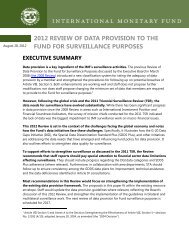ECB Annual Report on supervisory activities
ssmar2016.en.pdf?utm_source=POLITICO.EU&utm_campaign=b1bb431652-EMAIL_CAMPAIGN_2017_03_23&utm_medium=email&utm_term=0_10959edeb5-b1bb431652-189797857&utm_source=POLITICO
ssmar2016.en.pdf?utm_source=POLITICO.EU&utm_campaign=b1bb431652-EMAIL_CAMPAIGN_2017_03_23&utm_medium=email&utm_term=0_10959edeb5-b1bb431652-189797857&utm_source=POLITICO
You also want an ePaper? Increase the reach of your titles
YUMPU automatically turns print PDFs into web optimized ePapers that Google loves.
either or both of the following criteria: (a) material exposures which are more than<br />
90 days past-due; (b) the debtor is assessed as unlikely to pay its credit obligati<strong>on</strong>s<br />
in full without realisati<strong>on</strong> of collateral, regardless of the existence of any past-due<br />
amount or of the number of days past due.”<br />
Opti<strong>on</strong>s and nati<strong>on</strong>al discreti<strong>on</strong>s (ONDs): opti<strong>on</strong>s are provisi<strong>on</strong>s in EU law that<br />
give competent authorities or Member States a choice <strong>on</strong> how to comply with a<br />
provisi<strong>on</strong> selecting from a range of alternatives. Nati<strong>on</strong>al discreti<strong>on</strong>s are provisi<strong>on</strong>s<br />
in EU banking law that give competent authorities or Member States a choice as to<br />
whether or not to apply a given provisi<strong>on</strong>.<br />
Overall capital requirements (OCR): the sum of the total SREP capital ratio (sum<br />
of own funds requirements as set out in Article 92 of the Capital Requirements<br />
Regulati<strong>on</strong> and additi<strong>on</strong>al own funds requirements), capital buffer requirements and<br />
macroprudential requirements.<br />
Passporting procedures: procedures c<strong>on</strong>cerning the freedom of establishment<br />
and the freedom to provide services in other Member States by any credit instituti<strong>on</strong><br />
authorised and supervised by the competent authorities of another Member State,<br />
provided that such <strong>activities</strong> are covered by the authorisati<strong>on</strong> (as regulated by<br />
Articles 33 to 46 of CRD IV).<br />
Pillar 2 guidance (P2G): a <strong>supervisory</strong> tool setting n<strong>on</strong>-legally binding capital<br />
expectati<strong>on</strong>s above the level of overall capital requirements (OCR). It is<br />
complementary to Pillar 2 requirements (P2R). P2G is not MDA relevant and a<br />
failure to meet Pillar 2 guidance does not result in automatic acti<strong>on</strong> by the<br />
supervisor.<br />
Qualifying holding: a holding in a credit instituti<strong>on</strong> which represents 10% or more<br />
of the capital or of the voting rights or which makes it possible to exercise a<br />
significant influence over the management of that credit instituti<strong>on</strong>.<br />
Significant instituti<strong>on</strong> (SI): the criteria for determining whether banks are<br />
c<strong>on</strong>sidered significant – and therefore under the <str<strong>on</strong>g>ECB</str<strong>on</strong>g>'s direct supervisi<strong>on</strong> – are set<br />
out in the SSM Regulati<strong>on</strong> and the SSM Framework Regulati<strong>on</strong>. To qualify as<br />
significant, banks must fulfil at least <strong>on</strong>e of those criteria. Notwithstanding the<br />
fulfilment of the criteria, the SSM can decide at any time to classify an instituti<strong>on</strong> as<br />
significant to ensure that high <strong>supervisory</strong> standards are applied c<strong>on</strong>sistently.<br />
Single Supervisory Mechanism (SSM): a mechanism composed of the <str<strong>on</strong>g>ECB</str<strong>on</strong>g> and<br />
nati<strong>on</strong>al competent authorities in participating Member States for the exercise of the<br />
<strong>supervisory</strong> tasks c<strong>on</strong>ferred up<strong>on</strong> the <str<strong>on</strong>g>ECB</str<strong>on</strong>g>. The <str<strong>on</strong>g>ECB</str<strong>on</strong>g> is resp<strong>on</strong>sible for the effective<br />
and c<strong>on</strong>sistent functi<strong>on</strong>ing of this mechanism, which forms part of the banking<br />
uni<strong>on</strong>.<br />
SSM Framework Regulati<strong>on</strong>: the regulatory framework setting out the practical<br />
arrangements c<strong>on</strong>cerning the cooperati<strong>on</strong> between the <str<strong>on</strong>g>ECB</str<strong>on</strong>g> and the nati<strong>on</strong>al<br />
competent authorities within the Single Supervisory Mechanism, as provided for in<br />
the SSM Regulati<strong>on</strong>.<br />
<str<strong>on</strong>g>ECB</str<strong>on</strong>g> <str<strong>on</strong>g>Annual</str<strong>on</strong>g> <str<strong>on</strong>g>Report</str<strong>on</strong>g> <strong>on</strong> <strong>supervisory</strong> <strong>activities</strong> 2016 − Glossary 77



